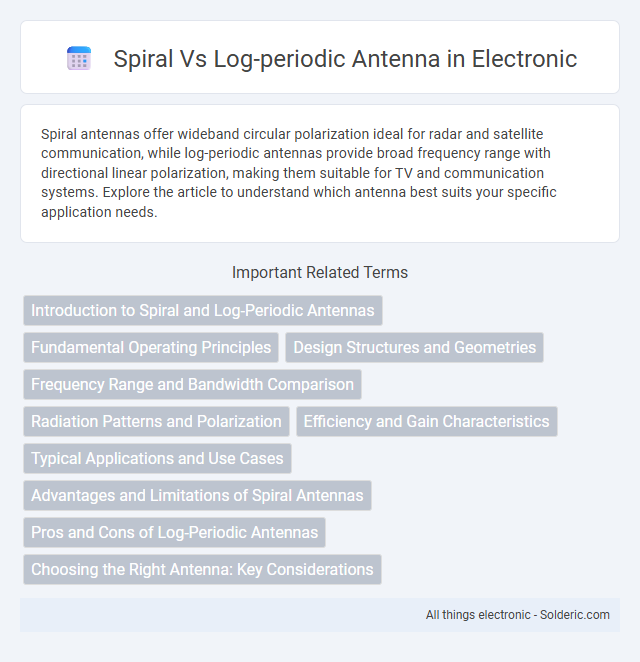Spiral antennas offer wideband circular polarization ideal for radar and satellite communication, while log-periodic antennas provide broad frequency range with directional linear polarization, making them suitable for TV and communication systems. Explore the article to understand which antenna best suits your specific application needs.
Comparison Table
| Feature | Spiral Antenna | Log-Periodic Antenna |
|---|---|---|
| Frequency Range | Ultra wideband, typically GHz range | Wideband, typically MHz to GHz range |
| Radiation Pattern | Broad, mostly circular polarization | Directional, linearly polarized |
| Gain | Moderate gain (5-10 dBi) | Moderate to high gain (6-15 dBi) |
| Polarization | Circular polarization | Linear polarization |
| Physical Size | Compact, planar design | Larger, elongated structure |
| Application | Radar, EMC testing, wideband communication | Television reception, HF/VHF/UHF communication |
| Impedance | Stable ~50 ohms across wide frequencies | Variable impedance, usually matched with balun |
Introduction to Spiral and Log-Periodic Antennas
Spiral antennas are frequency-independent devices characterized by their wideband performance and circular polarization, often used in radar and communications applications. Log-periodic antennas consist of a series of dipole elements with lengths and spacings that vary logarithmically, enabling operation over a broad frequency range with directional gain. Both antenna types provide broadband capabilities but differ in design principles, radiation patterns, and typical use cases.
Fundamental Operating Principles
Spiral antennas operate based on frequency-independent geometry that supports traveling wave currents, enabling wide bandwidth and circular polarization through self-similar spiral arms. Log-periodic antennas function using a sequence of dipole elements of varying lengths and spacing, which create periodic impedance and radiation patterns for multi-band and broadband performance across discrete frequency ranges. The fundamental difference lies in the spiral antenna's continuous frequency scalability versus the log-periodic's discrete frequency tuning via element structure.
Design Structures and Geometries
Spiral antennas feature continuous, smooth curves forming Archimedean or logarithmic spirals, enabling wideband frequency coverage and circular polarization with compact, planar designs. Log-periodic antennas consist of a series of dipole elements of varying lengths and spacing arranged logarithmically along a boom, producing directional patterns with stable gain and impedance over a broad frequency range. The spiral's self-similar geometry contrasts with the discrete, tapered structure of log-periodic antennas, each optimized for specific broadband applications and radiation characteristics.
Frequency Range and Bandwidth Comparison
Spiral antennas offer ultra-wideband frequency coverage, typically spanning multiple octaves, making them ideal for applications requiring continuous frequency agility from VHF through microwave ranges. Log-periodic antennas provide wideband performance with a more defined frequency range, usually covering several octaves as well, but with better gain stability and directivity across the band. Your choice depends on whether ultra-wideband flexibility (spiral) or consistent gain with directional control (log-periodic) suits your frequency range and bandwidth needs.
Radiation Patterns and Polarization
Spiral antennas exhibit broad, frequency-independent radiation patterns with circular polarization, making them ideal for wideband applications and consistent signal reception. Log-periodic antennas feature directional, frequency-dependent radiation patterns and typically use linear polarization, providing higher gain and improved performance in targeted signal transmission. Understanding these differences helps you select the appropriate antenna for applications requiring specific radiation pattern characteristics and polarization types.
Efficiency and Gain Characteristics
Spiral antennas provide wide bandwidth and circular polarization with moderate gain, making them efficient for applications requiring broad frequency coverage and consistent radiation patterns. Log-periodic antennas typically offer higher gain and directivity across a wide frequency range but with linearly polarized radiation, enhancing signal strength in targeted directions. Your choice depends on whether efficiency over a broad spectrum or higher gain with focused radiation is more critical for your application.
Typical Applications and Use Cases
Spiral antennas are commonly used in wideband communication systems, electronic warfare, and direction-finding equipment due to their circular polarization and frequency-independent characteristics. Log-periodic antennas are favored in applications requiring multi-band operation and high gain, such as television broadcasting, HF and VHF communications, and spectrum monitoring. Both antenna types serve crucial roles in radar systems and wireless communication, with spiral antennas excelling in broadband signal reception and log-periodic antennas offering precise frequency agility.
Advantages and Limitations of Spiral Antennas
Spiral antennas offer wideband frequency coverage and circular polarization, making them ideal for applications requiring consistent signal reception across a broad spectrum. Their compact, planar design enhances integration into various devices but results in lower gain and efficiency compared to log-periodic antennas. You may encounter limitations in directivity and power handling, which should be considered when selecting the antenna for high-performance communication systems.
Pros and Cons of Log-Periodic Antennas
Log-periodic antennas offer wide bandwidth and consistent gain, making them ideal for applications requiring frequency agility and directionality, such as TV reception and communication systems. However, they tend to be larger and more complex compared to spiral antennas, which limits portability and can complicate installation. Your choice depends on whether wide frequency coverage and gain stability outweigh the antenna's size and structural demands.
Choosing the Right Antenna: Key Considerations
Choosing between spiral and log-periodic antennas depends on bandwidth requirements and radiation pattern preferences. Spiral antennas offer wideband circular polarization and compact design, making them ideal for applications requiring frequency agility and consistent polarization. Log-periodic antennas provide linearly polarized, directional coverage with high gain across a broad frequency range, suitable for long-distance communication and signal tracking.
spiral vs log-periodic antenna Infographic

 solderic.com
solderic.com